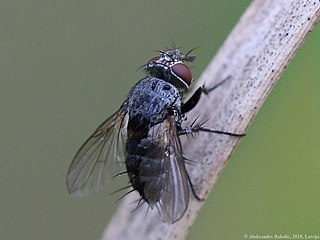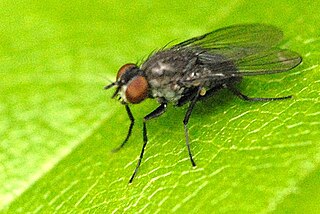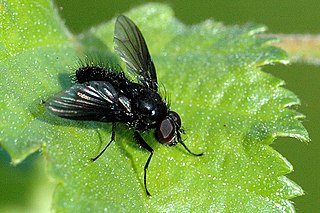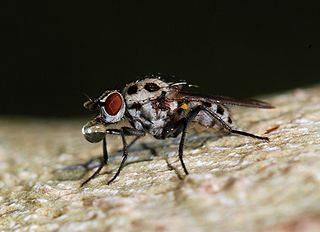
Sarcophagidae are a family of flies commonly known as flesh flies. They differ from most flies in that they are ovoviviparous, opportunistically depositing hatched or hatching maggots instead of eggs on carrion, dung, decaying material, or open wounds of mammals, hence their common name. Some flesh fly larvae are internal parasites of other insects such as Orthoptera, and some, in particular the Miltogramminae, are kleptoparasites of solitary Hymenoptera. The adults mostly feed on fluids from animal bodies, nectar, sweet foods, fluids from animal waste and other organic substances. Juveniles need protein to develop and may be laid on carrion, dung or sweet plant foods.

Helina is a very large genus from the fly family Muscidae.

The Anthomyiidae are a large and diverse family of Muscoidea flies. Most look rather like small houseflies, but are commonly drab grey. The genus Anthomyia, in contrast, is generally conspicuously patterned in black-and-white or black-and-silvery-grey. Most are difficult to identify, apart from a few groups such as the kelp flies that are conspicuous on beaches.

The Lauxaniidae are a family of acalyptrate flies. They generally are small flies with large compound eyes that often are brightly coloured in life, sometimes with characteristic horizontal stripes, such as in Cestrotus species. Many species have variegated patterns on their wings, but in contrast they generally do not have variegated bodies, except for genera such as Cestrotus, whose camouflage mimics lichens or the texture of granitic rocks.

Delia flies are members of the Anthomyiidae family within the superfamily Muscoidae. The identification of different species of Delia can be very difficult for non-specialists as the diagnostic characteristics used for immature and/or female specimens may be inconsistent between species. Past taxonomic keys were not as comprehensive in their identification of Delia specimens; they were either too reliant on genetic characteristics, focused solely on a specific life stage, or were focused only on certain species. However current taxonomic keys aim to be more thorough by not only including morphological diagnostics for males, females, and immature specimens of various species, but also their genetic make-up or molecular barcode.

Pegomya is a genus of flies within the family Anthomyiidae. Some species are considered pests due to their leafmining larvae. Species include:

Phaonia is a very large genus from the fly family Muscidae. It is distributed worldwide, with more than 750 species having been identified.

Ceromya is a genus of tachinid flies in the family Tachinidae, containing the following species:
Entomophaga is a genus of flies in the family Tachinidae. It was reviewed by T. Tachi and H. Shima in 2006 and was found to be paraphyletic; it was also found to form a monophyletic group with Proceromyia.

Peribaea is a genus of flies in the family Tachinidae.

Actia lamia is the type species of the genus Actia of the family Tachinidae.

Actia is a genus of large flies in the family Tachinidae.

Coenosia is a very large genus of true flies of the family Muscidae.

Spilogona is a very large genus of flies from the family Muscidae.

Anthomyia is a genus of flies in the family Anthomyiidae. They look rather like small houseflies, but commonly have conspicuous black-and-white patterning. This appears to be a mild form of aposematic coloration, though they do not appear to be distasteful unless they have eaten something offensive to the predator and have loaded their guts with it.

Siphonini is a tribe of flies in the family Tachinidae.
Caricea is a genus of house flies, in the family Muscidae. There are at least 30 described species in Caricea.

Leucophora is a genus of root-maggot flies in the family Anthomyiidae. There are at least 60 described species in Leucophora.

Chirosia is a genus of root-maggot flies in the family Anthomyiidae. There are over fifty described species in Chirosia.

Egle is a genus of willow catkin flies in the family Anthomyiidae. There are at least 40 described species in Egle.
DELY-DRASKOVIT, Á., 1993. Family Anthomyiidae. In Soós, Á. & Papp, L. (eds): Catalogue of Palaearctic Diptera, Vol. 13, pp. 90–92. Akadémiai Kiadó, Budapest.

















